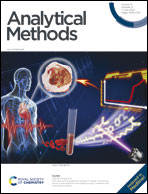A fast survey on recent developments in designing colorimetric and fluorescent sensors for the selective detection of essential amino acids
Abstract
Owing to the biological significance of various amino acids, developing accurate and cost-effective sensing techniques for the selective detection of amino acids has recently attracted growing interest. This review discusses the recent advancements of chemosensors in the selective detection of only essential amino acids out of a total of twenty amino acids, which have been applied in chemosensing research, and the mechanism of their action. The focus is directed towards the detection of the most important essential amino acids, like leucine, threonine, lysine, histidine, tryptophan and methionine, since isoleucine and valine are yet to be explored in regard to chemosensing. According to their chemical and fluorescence properties, different sensing techniques, such as the reaction-based approach, DNA-based sensors, nanoparticle formation, coordination ligand binding, host–guest chemistry, the fluorescence indicator displacement (FID) approach, electrochemical sensors, carbon dot-based sensors, MOF-based sensors and metal-based techniques, have been described.

- This article is part of the themed collection: Analytical Methods Review Articles 2023


 Please wait while we load your content...
Please wait while we load your content...